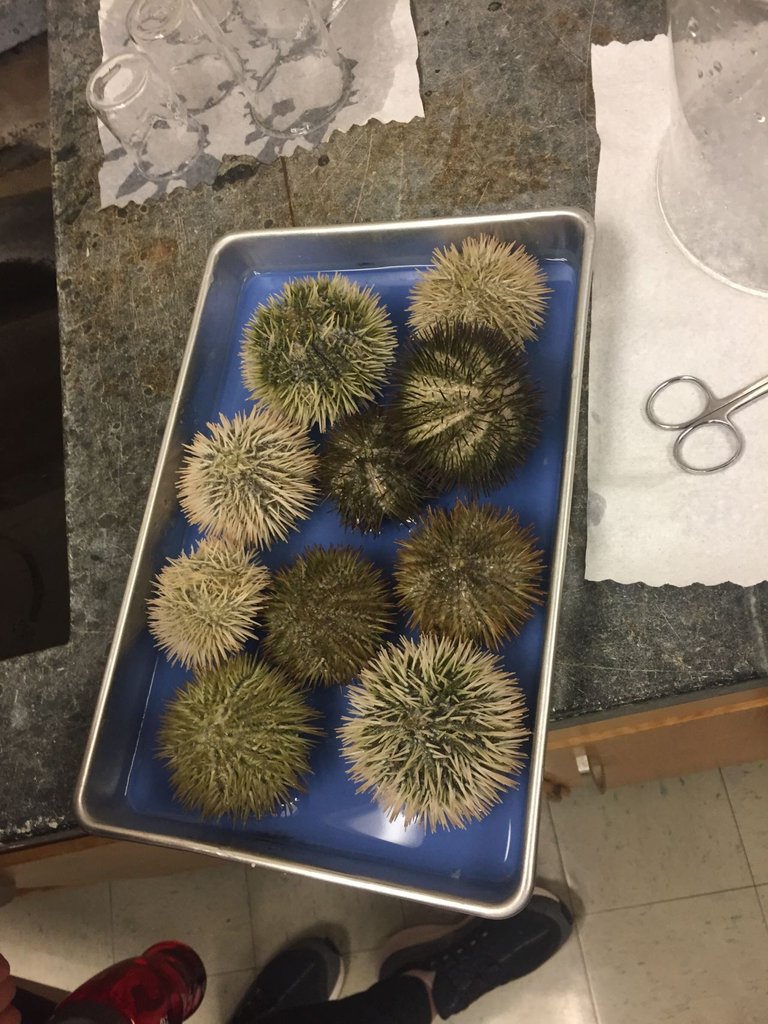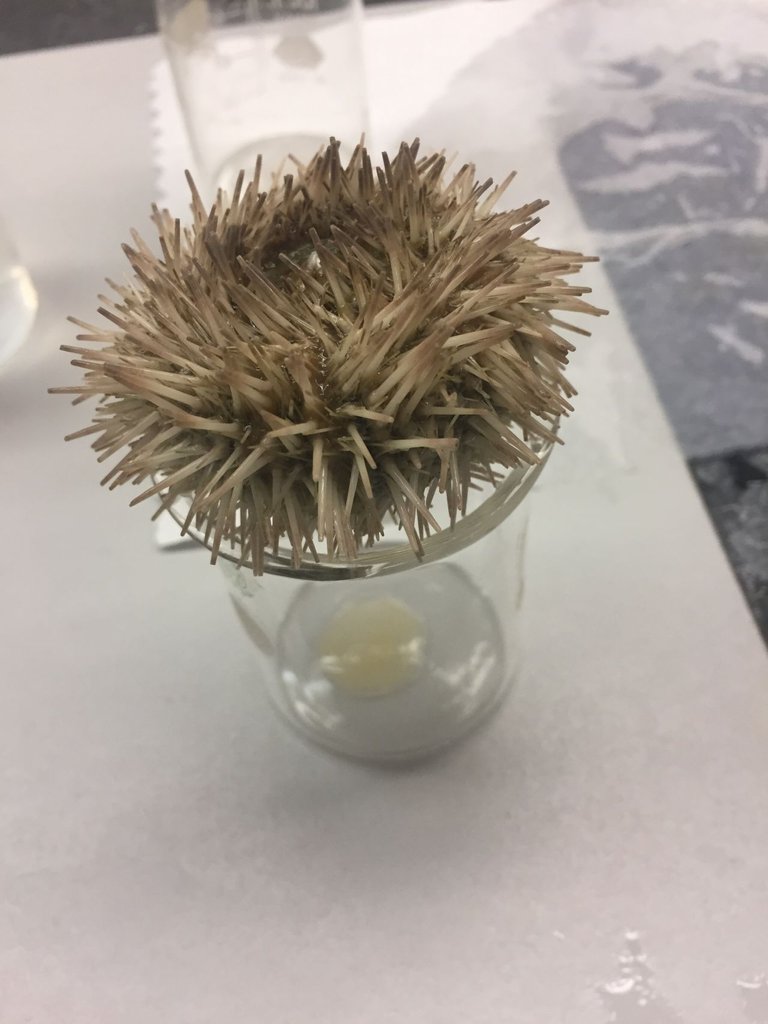Welcome to my series documenting my trials and tribulations as I foray into academia. I’ve recently been put in charge of a college-level course in developmental biology. I do have a colleague handling the corresponding lecture, but ultimately the responsibility for the labs falls on me. Labs are three hours long and are held once a week for 13 weeks total.
Designing this course has been fun, but challenging. The course hasn’t really been run before and most of the labs have to either be created from scratch or modified from protocols found within the Bio department or by searching the internet. It's also hard to think of an appropriate lab that’s specific to developmental biology, but doesn't overlap with typical labs in a molecular biology, genetics, or anatomy course and fits within three hours. I haven't been able to find many resources online for creating this type of course so I thought I'd post my labs on SteemSTEM after I make them.
In past weeks, the students have experimented on human placenta and living chick embryos. This week we've moved onto a new organism: The sea urchin.

Developing this Lab
Sea Urchins are one of the more unique organisms found in a developmental biology lab. They’re primarily used as a model organism for egg fertilization experiments and not much else (https://askabiologist.asu.edu/explore/sea-urchins-do-research). Fortunately, they’re very well suited for such experiments and it’s quite easy for students to learn to work with them. A simple fertilization can be done in under an hour and variations to the fertilization experiment can be easily implemented.
This was one of the last labs my students performed before the end of the semester. Previous labs had mostly stripped away the hand-holding aspects and I wanted to make the students do as much as the experimental design as they could handle. Every student in lab was issued a digital lab manual of Developmental Biology: A Guide for Experimental Study by Mary S. Tyler (https://onlinelibrary.wiley.com/doi/abs/10.1002/ajmg.1320590229). This book contains a chapter on sea urchins that should have all the information needed to design a lab around them. If this book is unavailable, Swarthmore has an online lab manual for sea urchins that can do in a pinch (https://www.swarthmore.edu/NatSci/sgilber1/DB_lab/DB_lab.html).
These lab manuals were used because they don’t clearly spell out a protocol. Instead, students spent half of one lab reading through the manual to find certain variables like the components of sea water, normal fertilization temperature, and how to induce urchins to release gametes. To make sure every student ended up with the same protocol, I created a power point that ultimately laid out the protocol as students successfully described each step. They then spent the other half of the lab making necessary reagents (artificial sea water and 0.5 M KCl) and preparing glassware and other equipment. By then end of this lab, students were expected to be fully prepared to begin working with sea urchins at the start of the second lab.
For my part, I had to make sure that at least 2 sea urchins (Lytechinus variegatus) were available for each group to work with. These can be a bit tricky to find online, but companies like http://www.marinusscientific.com/ should have them available as long as they have a week or two notice. These sea urchins arrived in a large insulated container with each sea urchin sequestered to a plastic bag filled with water. We kept them at room temperature in the bags they shipped with. Most survived several days in those bags will no ill effects. We could tell that they were alive because they’d wiggle when we held them.
(html comment removed: [if gte vml 1]>
<![endif]) (html comment removed: [if !vml])(html comment removed: [endif])
(html comment removed: [if !vml])(html comment removed: [endif])
Several sea urchins used in this experiment
The full lab protocol is included below, but I’ll describe
how it works with pictures here as well.
Sea urchins are spiny balls, but half two distinct sides. One side as a mouth and the other has an
anus. All lab groups would grab a single
sea urchin and inject 0.5 M KCl around the edges of the mouth with a syringe.

Injecting a sea urchin.
The syringe had to be sharp enough to pierce the soft tissue around the mouth of the sea urchin, but students had to be careful to not damage the organism too much or inject too much liquid. The 0.5 M KCl would cause the sea urchins to release gametes out their back sides to the sea urchins then had to be placed ass down over a beaker.

A Sea urchin releasing eggs
Within minutes the sea urchin would start to release either sperm (white) or eggs (yellow). Students would do this for multiple sea urchins until they had both a sperm and egg, then they’d mix the sperm and egg together in a petri dish to fertilize them. We’d analyze the gametes under a microscope to see if fertilization occurred. The presence of an envelope around an egg usually indicated successful fertilization.

A fertilized egg with an envelope
Students had to then come in the next day to calculate the percentage of eggs that had been fertilized. Students were also instructed to design an additional experiment to push their protocol beyond a simple fertilization. For example, they could adjust temperature and see if that affected fertilization efficiency.
Protocol
Materials
0.5 M KCl
Artificial Sea Water:
28.32 g NaCl
0.77 g KCl
5.41 g MgCl2·6H2O
7.13 g MgSO4·7H2O
1.18 g CaCl2
H2O to 1 Liter
Protocol for collecting sea urchin gametes
1. Induce spawning – inject 1 ml of 0.5 M KCL into the soft membrane around the mouth
2. Gametes should appear within minutes
Sperm are off-white
Eggs are tan-orange
3. Collect the sperm by inverting the male onto a small beaker à cover the sperm and place on ice
4. Collects the eggs by inverting the female onto a beaker filled with artificial sea water à allow eggs to settle. Pour out ASW and replace with fresh ASW.
Standard Fertilization protocol
1. Wash eggs with 10 mL artificial sea water (3 times)
2. Dilute 50 uL sperm in 5 mL ASL
3. Add 100 uL diluted sperm to 10 mL artificial sea water containing eggs in petri dish
4. Check for signs of fertilization under the dissecting scope
5. Cover petri dishes and wait 24 hours. Calculate percentage of fertilized eggs
Turning this into an experiment
1. You will perform both a standard fertilization and an experimental fertilization
The experimental fertilization will change one variable to the standard protocol to see if it affects fertilization efficiency
2. Adjusting temperature, ion concentration, pH, light conditions, exposure to UV light, etc.
3. In your lab notebooks, you will include an extra paragraph in your conclusion explaining your results
Final Thoughts
This lab went very well. My only real complaint is that it was my first time working with these creatures and I wasn’t as effective an instructor due to my own inexperience. Fortunately, my lab assistant had worked with them before and saved my bacon on a number of occasions.
I’m not sure if I’ll continue this series. I’ve highlighted my favorite labs and I may want to go back to covering research papers for a bit. We’ll see what happens. Thanks for reading!
This looks like fun. I am wondering how many students mix the urchin anus and mouth... :D
What happened to the eggs after the experiments? Have you been growing them or have there just been classified as waste?
Few students made the mistake because the mouth and anus are pretty distinct and it's hard to poke the anus with a needle :P
We threw out all the eggs after the experiments. No real need for em and no one wanted to try growing sea urchins.
Thanks for the extra bits of information (I have never checked an urchin from the very close to be honest... so I didn't know ;) )
Oh we have lots of those pesky prickly monsters in the seas of Paphos, were you must constantly float or swim lest you step on one of them and have your foot hurt for weeks! Their only saving grace is they can be eaten :D That, and apparently being useful in labs :P
Hah! They're virtually unknown where I'm from so much of the class hadn't seen or touched one before.
I only know how to eat them. (^.^) I didn't know they are so well suited for fertilization experiments. Seems like a pretty cool experiment.
Hah! I had them once in Japan and didn't mind the taste, but Sea Urchins as food is almost unheard of where I'm from. We threw the guys out at the end so maybe some hungry student fished them out of the trash for a quick lunch :P
Well, this seems like an interesting series. I admit to knowing next to nothing about developmental biology, I hope to learn more about it from you. By the way, those experiments with human placenta and living chick embryos, did you make articles about them? They sound like something really worth reading!
Posted using Partiko Android
Glad you like the series. The Placenta post can be found at https://www.steemstem.io/#!/@tking77798/developing-a-develop-1549556482 and the chick embryo lab post can be found at https://www.steemstem.io/#!/@tking77798/developing-a-develop-1554777924.
Hey there, thanks for this article. Does the sperm cells also have tails like ours?
Regards
Chapper
The sperm are supposed to have tails so they can move in water to the nearest egg. However, they're so much smaller than an egg that I wasn't able to resolve them under a microscope.
Congratulations @tking77798! You have completed the following achievement on the Steem blockchain and have been rewarded with new badge(s) :
You can view your badges on your Steem Board and compare to others on the Steem Ranking
If you no longer want to receive notifications, reply to this comment with the word
STOPTo support your work, I also upvoted your post!
Vote for @Steemitboard as a witness to get one more award and increased upvotes!
This post has been voted on by the SteemSTEM curation team and voting trail. It is elligible for support from @curie and @utopian-io.
If you appreciate the work we are doing, then consider supporting our witness stem.witness. Additional witness support to the curie witness and utopian-io witness would be appreciated as well.
For additional information please join us on the SteemSTEM discord and to get to know the rest of the community!
Thanks for having added @steemstem as a beneficiary to your post. This granted you a stronger support from SteemSTEM.
Thanks for having used the steemstem.io app. You got a stronger support!
Hi @tking77798!
Your post was upvoted by Utopian.io in cooperation with @steemstem - supporting knowledge, innovation and technological advancement on the Steem Blockchain.
Contribute to Open Source with utopian.io
Learn how to contribute on our website and join the new open source economy.
Want to chat? Join the Utopian Community on Discord https://discord.gg/h52nFrV
Touching the sea urchin would give me an anxiety attack. I'll stick with enzymes. At least I cant see how gross they are :p
Hah! I don't think anyone in lab had too much difficulty holding them, but everyone was super gentle at first. They're so tough and the spines aren't as sharp as, say thorns, so it's not too bad.
Great to hear from you BTW (I def gotta start checking steemit more often).
I don't really spend much time here. Busy with work and life these days. How's the kiddo??
I suppose my delayed response means I don't visit this site too frequently anymore. The kid is good and I've been promoted to visiting professor so life is busy but satisfying. I'll try shooting you a text sometime soon to catch up.
Sounds good man, I'd like to catch up!